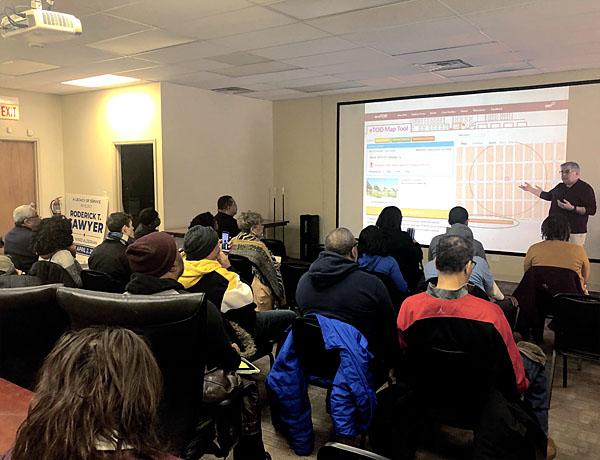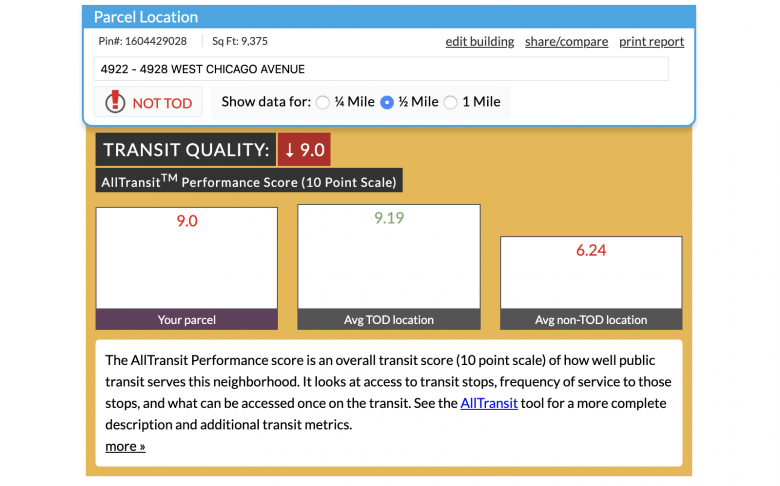Transit-oriented development (TOD) anchors vibrant communities around transit stops. When homes, offices, retail, and other amenities are located nearby, people can spend less time and money getting to all the places in their daily lives. Equitable transit-oriented development (eTOD) takes this a step further by making sure that the benefits of living and working near transit are available to people of all races and income levels. For the past three years, CNT has been working with Elevated Chicago to advance eTOD in a variety of ways.

CNT recently wrapped up a series of three in-person eTOD workshops, each in partnership with local aldermen and community organizations (details in the table below). The goal of these workshops was to familiarize neighborhood stakeholders with the Chicago TOD ordinance and gain their input in the development of Chicago’s eTOD Policy Implementation Plan.
Here are our top three takeaways and questions.
#1 Level of transit service is important.
Residents of the 37th Ward were excited to learn about a pilot program that could put new electric buses on the #66 Chicago Avenue bus line ahead of the CTA’s schedule to convert to a 100% electric fleet by 2040. They also expressed challenges associated with late night commutes, when buses run less frequently and eventually stop running. In 2019, Chicago’s TOD ordinance expanded to include high frequency bus corridors, in part to encourage more affordable, mixed use development in neighborhoods with transit access. It’s still difficult to measure the impact of the bus TOD ordinance after a little over a year, but if resident concerns about bus service are any indication, the City may need to consider enhancements to bus service before the ordinance has any real impact on nearby development. What kinds of CTA bus service improvements -increases in service hours or frequency, better express service, or improvements in the public right of way- would improve resident transportation and encourage new development?

#2 The City needs to proactively engage communities to avoid conflicts with active and shared mobility.
In both the 37th and 49th Wards, residents and community organizations took note of the Divvy dock rollout over the past several years. They liked the increased access to trains, buses, jobs, and other amenities through active transportation. Divvy also offers reduced annual memberships through its Divvy for Everyone (D4E) program, which allows access to people without credit cards as well. Some expressed concerns about conflicts with buses and parked cars, worrying that riders could be in danger without more striped or protected bike lanes. On Sheridan Road, residents express fears that conflicts with parked cars and buses make cycling more dangerous. Yet, community organizations noted that safer parallel routes and the lakefront path are easily accessible nearby. It’s no secret longtime cyclists use a variety of apps to find bikes, routes, and other things, but less experienced riders may not have the same access or comfort level consuming information in that way. As new bicycle facilities continue to roll out in the form of protected lanes, trails, and Divvy docks, how can the City proactively engage communities to ensure that people’s first rides are safe and easy?
#3 Longtime neighborhood businesses and local entrepreneurs should be able to benefit from TOD policies and programs.
Affordable housing must be preserved and developed near transit, or incentives are likely to produce luxury developments and risk displacement of longtime residents in neighborhoods where real estate markets are heating up. However, large parts of Chicago’s south and west sides haven’t seen this kind of investment in TOD or many developers taking advantage of the TOD ordinance at all. Both 37th and 6th Ward residents expressed frustration in how far they have to travel for basic amenities and how difficult it is for local businesses and entrepreneurs to take advantage of economic development programs offered by the City, such as the Neighborhood Opportunity Fund. What kinds of next wave City TOD programs and policies can help attract investment where it is needed most and ensure that investments support local businesses and entrepreneurs?
These are the questions on our minds as CNT and other organizations continue to push forward the eTOD Policy Implementation Plan mandated for City adoption in August. Please continue to check our events page for our next eTOD webinar this spring!





 Strengthening Transit Through Community Partnerships
Strengthening Transit Through Community Partnerships

